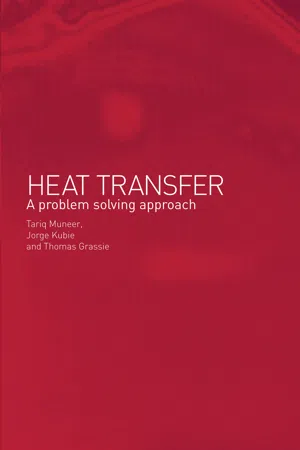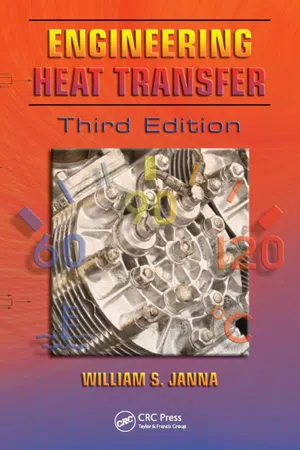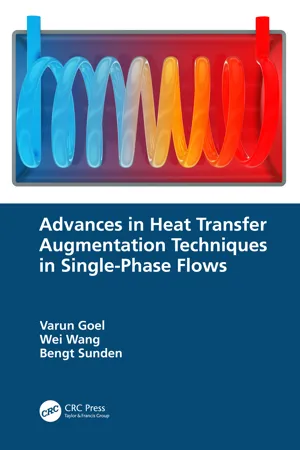Technology & Engineering
Forced Convection
Forced convection refers to the movement of fluid, such as air or water, through a system due to an external force, such as a fan or pump. This process enhances heat transfer and is commonly used in various engineering applications, such as cooling systems in electronics, HVAC systems, and industrial processes. Forced convection is characterized by a higher heat transfer rate compared to natural convection.
Written by Perlego with AI-assistance
Related key terms
Related key terms
1 of 4
Related key terms
1 of 3
6 Key excerpts on "Forced Convection"
- eBook - ePub
Heat Transfer
A Problem Solving Approach
- Kubie Jorge, Tariq Muneer, Grassie Thomas(Authors)
- 2012(Publication Date)
- Routledge(Publisher)
7 Forced Convection
7.1 Introduction
The main factors affecting the rate of convective heat transfer were introduced in Chapter 6 . Convection heat transfer was classified according to the mode, that is, either free or forced , the type of flow, either laminar or turbulent , and the flow geometry, either internal or external . In free convection , the temperature difference between a body and the quiescent surroundings induces a density differential in the fluid surrounding the body. Gravitational effects acting on this density differential create a buoyancy force. This buoyancy force has the impetus to cause displacement in the surrounding fluid thus establishing fluid motion around the body in the form of free convection currents. A full analysis of the factors that affect the free convection heat transfer coefficient for different flow regimes and geometries is presented in Chapter 8 .In this chapter, however, we shall concern ourselves with convection heat transfer in situations where fluid flow is induced by some external means such as a pump or a fan. The heat transfer promoted by this means is referred to as Forced Convection and may be studied, as outlined in Chapter 6 , in terms of two sub-topics, namely, external and internal flow. In the case of external flow, boundary layers are generally able to develop freely, whereas, for internal flow, as will be discussed in Section 7.3 , the constraints imposed by adjacent surfaces affect their development. Hence, a separate analysis is required for each of these flow regimes. The importance of the interrelationship of the three dimensionless parameters, namely, the Reynolds, Prandtl, and Nusselt numbers, in defining the convective heat transfer coefficient for Forced Convection systems was introduced in Chapter 6 . The general form of the equation relating these three parameters, inferred from dimensional analysis and experimental measurements, is given as in Eq. (7.1.1) - eBook - ePub
- Debasish Sarkar(Author)
- 2023(Publication Date)
- Wiley(Publisher)
Sc are discussed in the previous section. Bulk fluid motion facilitates the heat transfer and convection mechanism. Convection is further subdivided into two categories: free (or natural), and another is Forced Convection, based on how the action of fluid originated. In free convection, any fluid motion is initiated by natural means, such as the differences in density and effect of buoyancy, and the rise and fall of warmer and cooler fluid, respectively. Whereas in Forced Convection, the motion of the fluid is forced to flow over a surface or in a circular section by external agency means a fan or pump. Such a convection process can be observed when air is supplied or extracted by a blower or suction pump into a tunnel kiln to maintain heat and mass-transfer, turbulence in tundish, and subsequent consistent flow control during casting, etc. Forced Convection creates a more uniform temperature throughout the entire region. Essential information for the convection in the confined region may provide insight into this understanding and is discussed in the next section.The convection heat transfer from or to the surface of a material may be calculated using Equation (1.15) , and empirical correlation:(1.48)Where Nusselt number (Nu) is equal to hL/k, the Reynolds number (Re) is ρuL/μ, and the Prandtl (Pr) is cp μ/k. From Equation (1.49) , the free convection coefficient can be estimated:(1.49)The Rayleigh number (Ra) is (Ts − T∞)βgρL3 /(αμ), where β is the volumetric thermal expansion coefficient, g is the gravitational acceleration, ρ is density, l is length, and α is thermal diffusivity. The constants c, n, and m for different geometry and flow conditions are available in the literature [4 , 5 ].1.4.4 Flow in Confined Region
Few real-life incidences represent an example of Forced Convection during the external flow of fluid. However, several incidences, including molten steel casting, experience confined region flow in a tube such as a slide gate, shroud, subentry nozzle, etc. The boundary layer develops on a surface in external flow and continues without external constraints. In contrast, the pipe’s fluid flow cannot form the boundary layer; rather, the hydrodynamic layer’s velocity affects the confined flow region. The convection heat transfer coefficients and energy balance are presented for internal flow in the circular channel, considering velocity and thermal boundary layer effects. - eBook - ePub
- British Gas(Author)
- 2014(Publication Date)
- Routledge(Publisher)
It is usually difficult in these circumstances to obtain analytical solutions to problems of heat conduction and generally numerical approximation methods have to be used. The time taken to reach steady-state conditions is very variable and is an important factor which has to be taken into account when heating furnace walls and loads and in designing regenerator systems. Refer to standard texts for detailed calculation methods under transient conditions.5.3 CONVECTION
5.3.1 Introduction and General Description
Convective heat transfer is the most important mode of heat transfer associated with liquids and gases and involves movement of the fluid to carry heat with it. The movement can be natural, due to density differences arising from temperature differences, or it can be forced, say by use of a fan. The transfer of heat by convection is commonly between a fluid and a solid surface and the rate of transfer will be increased by the use of some method of forcing the flow to provide turbulence. In general, the simplest way of increasing heat transfer is to increase the velocity of the gas or liquid to reduce the thickness of the boundary layer which clings to the solid surface. Natural convection is usually small in value unless the surface is vertical and with high surface temperature. Refer to Chapter 4 for a detailed exposition of the fluid flow considerations governing convection.There is rarely a need to increase the heat transfer of liquid-to-surface interfaces as these are inherently very high compared to that of air or gas. It should be noted that gas-to-surface heat transfer is usually the lowest and therefore the controlling factor of a system.In the preceding Section it was shown that the basic equation of conduction can give analytical solutions of heat transfer problems for single cases where information such as surface temperatures and conductivities are accurately known. Charts and tables can be used for more complicated problems. However, the solution of the differential equations that govern the transfer of heat by convection usually present considerable mathematical difficulties. There are a number of methods of calculating rates of heat transfer due to convection and the most important aspects are described below, although detailed information should be obtained from standard textbooks. - eBook - ePub
- Corky Binggeli(Author)
- 2015(Publication Date)
- Wiley(Publisher)
Convection occurs when the addition of heat to a liquid or gas (but not within a rigid solid) increases molecular activity, normally resulting in expansion of the substance and reducing its density. Liquid or gas particles are not held in a rigid position, so less dense molecules are able to rise. They are then replaced by other, more dense molecules. As more thermal energy is added, the more dense molecules heat up, expand, become less dense, and are themselves displaced. With convection, thermal energy is carried through the material by the movement of molecules, a process called fluid flow. Within a narrow air space where the friction of surrounding surfaces inhibits air movement, convection is limited.Natural (free) convection currents that occur without wind or a fan tend to create layers that are at different temperatures (stratification). Forced Convection occurs when a fluid (gas or liquid) is circulated between hotter and cooler areas by wind, fans, or pumps. Natural convection is not usually as powerful as forced airflow.When we look at this in detail, we see that convection combines conduction and fluid flow, with heat conducted between the region very close to a solid body and the solid itself. Fluid flow then rapidly transports heat to and from the boundary region by convection.Convection always involves a medium that picks up and transfers heat from one location to the other. (See Figure 12.6 ) The rate of convection is a function of the surface roughness and orientation, direction of flow, type of fluid, and whether the process is free or forced. Convection is often temperature dependant.Figure 12.6Convection in a heated fluidRADIATION
Radiation occurs when heat flows in electromagnetic waves from hotter surfaces through any medium, even the emptiness of outer space, to detached colder ones. It has a close relationship to the transfer of light. Radiant energy cannot go around corners or be affected by air motion.Internal energy or molecular vibrations set up by the electromagnetic waves that emanate from the warm object carry energy to all bodies within a direct line of sight. The waves excite molecules of the receiving bodies, which increases their internal energy. Examples of thermal radiation include the energy of the sun’s rays or of hot coals in a fire.Radiation involves the release or reception of energy in the form of photons. The emission of radiation occurs when molecular activity at the surface of a substance releases a photon. - eBook - ePub
- William S. Janna(Author)
- 2018(Publication Date)
- CRC Press(Publisher)
5 Introduction to Convection 5.1 IntroductionThe preceding chapters dealt primarily with conduction heat transfer. Convective effects were discussed briefly and considered almost exclusively as boundary conditions. In this and the following chapters, we turn our attention to the convection problem.There are two categories of heat transfer involving fluids: Forced Convection and free or natural convection. In Forced Convection, the fluid flow is established by an external driving force provided by, say, a fan or pump. In natural convection, the fluid flow is caused by the buoyant effect resulting from heating or cooling the fluid.The method of solution in forced- and natural-convection problems differs. Generally, for the forced-convection problem, the velocity profile is found first, which is then used to derive the temperature profile. For the natural-convection problem, the velocity and temperature profiles are intimately related and are therefore determined together. The final objective of an analysis is, again, to determine the heat-transfer rate. In either case, it is important to have information on the fluid properties that influence fluid flow and on the equations of motion for a fluid. These topics are discussed in this chapter.We will derive continuity, momentum, and energy equations that will be of use to us in formulating convection problems. The equations will be applied to some laminar-flow problems to show how the equations are reduced or simplified according to assumptions made in specific problems. Simplifying the general equations to obtain the applicable expression is the method recommended here rather than developing equations from an energy balance for each problem of interest. The recommended method is safer and provides a unifying overview of convection problems.In chapters that follow, we will consider laminar- and turbulent-flow problems and natural-convection problems in greater detail. This chapter thus serves as an introduction to convection by providing general equations of fluid mechanics and convection heat transfer. - Varun Goel, Wei Wang, Bengt Sunden(Authors)
- 2024(Publication Date)
- CRC Press(Publisher)
2 K) is introduced via Newton’s law of cooling, i.e.,(1.2)= α (Q ̇At f−t w) = h (t f−t w)In Eq. (1.2), the fluid temperature tf and the wall or surface temperature tw appear.In the literature, for example [1 and 2 ], values (orders of magnitude) of h or α are available. In Table 1.2 , representative values for air and water are provided.Table 1.2 Order of magnitude of the convective heat transfer coefficient for air and waterFluid Convection process Heat transfer coefficient (W/m2 K) Air Free, natural 2–25 Air Forced 25–250 Water Free, natural 50–1,000 Water Forced 50–20,000 Water Boiling 2,500–100,000 Water, vapor Condensation 5,000–100,000 When Forced Convection prevails, the α or h, depends on the fluid velocity, fluid type as well as geometry. The convective flow field is commonly characterized as laminar or turbulent. In laminar cases, the flow velocities are low, while in turbulent flow high velocities prevail. Conventionally, a Reynolds number, Re, is used to determine whether a flow field is to be regarded as laminar or turbulent.1.2.1 Dimensionless numbers in analysis of convection heat transfer
1.2.1.1 Reynolds number
The Reynolds number (Re) is a common dimensionless number used to determine whether a flow is laminar or turbulent. For tube or pipe flow, Re is defined,
Index pages curate the most relevant extracts from our library of academic textbooks. They’ve been created using an in-house natural language model (NLM), each adding context and meaning to key research topics.
Explore more topic indexes
Explore more topic indexes
1 of 6
Explore more topic indexes
1 of 4





